We’re not sure if anyone knows this, but according to our internal data on Samsung’s LED LCD TVs, in years gone by its Series 7 has generated the least interest among potential buyers: we suspect most people would either settle for the midrange Series 6 which delivers outstanding bang for the buck, or go straight to the flagship Series 8 with all the bells and whistles.
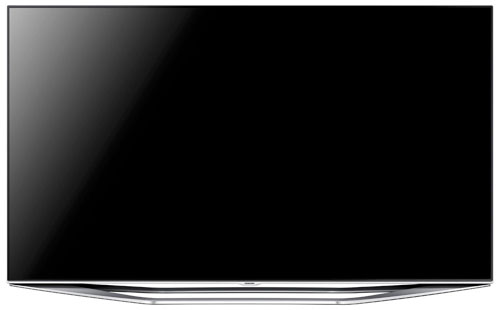
But this year, we think the Samsung H7000 will get more attention, since it’s the highest-end flat-screen 1080p model in the company’s 2014 TV lineup (the top-end H8000 range is curved, as far as full HD models go).
Design
We’ve taken in the 46-inch model (i.e. UE46H7000) for review, whose design is suitably attractive largely due to the uber-thin black bezel. The LCD panel sits on a non-swivel stand that spans the entire width of the screen, but because the sides are slanted upwards from the base, it can be placed on a narrower AV rack (good thinking there Samsung).
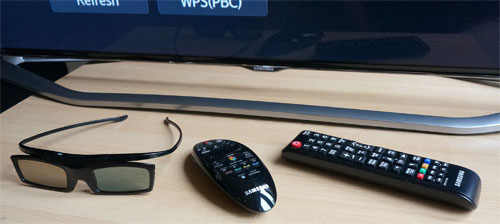
Features include edge LED backlighting, quad-core processor, a Clear Motion Rate (CMR) of 800, active 3D capabilities, inbuilt Freeview HD and satellite tuners, as well as the Korean brand’s comprehensive suite of catch-up and Smart TV services.
Connections
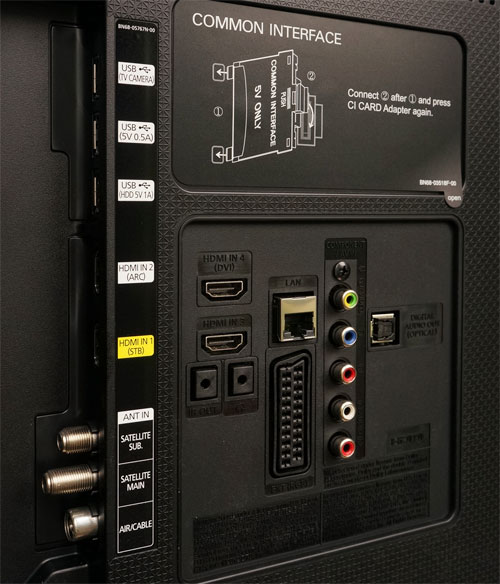 |
| Rear: 4x HDMI, 3x USB, component, SCART, aerial & satellite tuners, LAN, audio outs |
Calibration
Armed with a profiled Klein K10-A meter, a DVDO AVLab TPG signal generator and CalMAN 5.3 video calibration software, we used the comprehensive array of picture-affecting controls provided on the Samsung UE-46H7000 to calibrate its greyscale to D65, gamma to 2.4, and colour space to Rec.709 HDTV standard.
We achieved excellent results throughout, with delta errors (dEs) never exceeding the humanly perceptible threshold of 3 across all our measurements, which means that real-world content won’t be tinged with any visible inaccuracy.
Greyscale
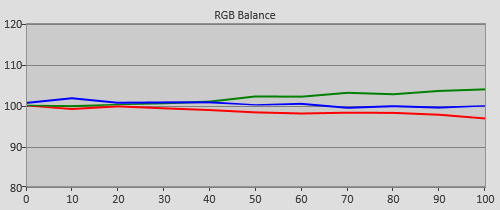 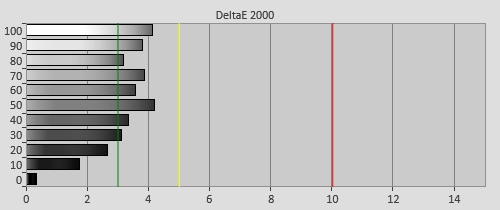 |
| Pre-calibration RGB tracking and delta errors (dEs) |
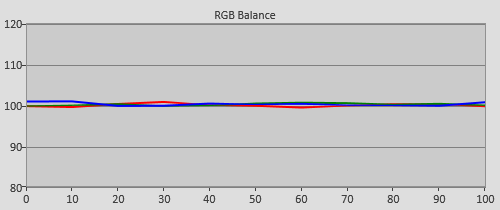 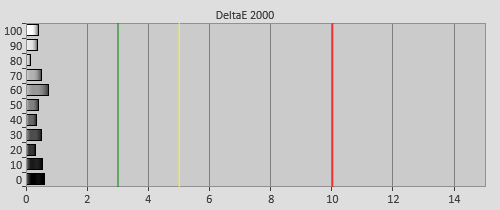 |
| Post-calibration RGB tracking and delta errors (dEs) |
Gamma
![Pre-calibrated Gamma tracking in [Movie] mode](/news/wp-content/uploads/2018/04/hdtv_Samsung-UE46H7000_pre-gamma.png) |
![Post-calibrated Gamma tracking in [Movie] mode](/news/wp-content/uploads/2018/04/hdtv_Samsung-UE46H7000_post-gamma.png) |
| Pre-calibration gamma tracking (2.19) | Post-calibration gamma tracking (2.4) |
Colour
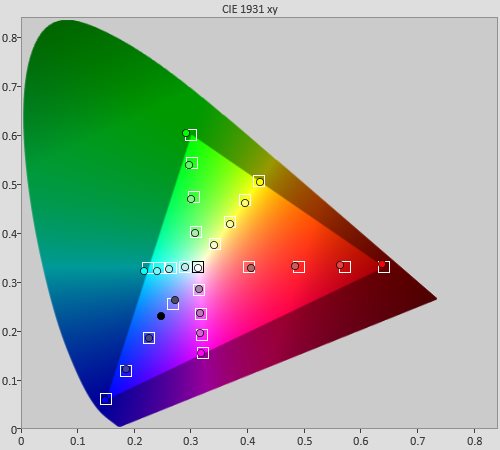 |
| Post-calibration colour saturation tracking in “Custom” [Colour Space] |
![Post-calibration colour errors in 'Custom' [Colour Space]](/news/wp-content/uploads/2018/04/hdtv_Samsung-UE46H7000_post-strack-de.png) |
| Post-calibration colour errors (<3 not appreciable to the eye) |
Benchmark Test Results
| Dead pixels | None |
| Screen uniformity | Excellent for an edge LED LCD |
| Overscanning on HDMI | 0% with [Picture Size] set to “Screen Fit“ |
| Blacker than black | Passed |
| Calibrated black level (black screen) | LEDs shut off |
| Calibrated black level (ANSI checkerboard) | 0.04 cd/m2 |
| Black level retention | Auto-dimming with full black screen |
| Primary chromaticity | Excellent |
| Scaling | Excellent |
| Video mode deinterlacing | Very effective jaggies reduction |
| Film mode deinterlacing | Passed 3:2 cadence over 480i & 1080i; and 2:2 over 576i |
| Viewing angle | Decent for VA LCD: washout occurs beyond 45° off-axis |
| Motion resolution | 1080 with [Motion Plus] engaged; 300 otherwise |
| Digital noise reduction | Optional; effective when engaged |
| Sharpness | Defeatable edge enhancement |
| Luma/Chroma bandwidth (2D Blu-ray) | Full luma; chroma horizontally blurred |
| 1080p/24 capability | No judder in 2D |
| Input lag (high-speed camera) | 32ms compared to lag-free CRT |
| Leo Bodnar input lag tester | 39ms in [PC] mode |
| Full 4:4:4 reproduction (PC) | Yes, with 60hz signal and [PC] input label |
Power Consumption
| Default [Standard] mode | 75 watts |
| Calibrated [Movie] mode | 56 watts |
| Standby | <1 watt |
Picture Quality
The Samsung UE46H7000 rendered a deep shade of blacks by LED LCD standards, with its native black level coming in at 0.04 cd/m2 on a 4×4 ANSI chequerboard pattern once we fixed peak white luminance to 120 cd/m2 as we always do in all our TV reviews to maintain a level playing field. Backlight uniformity on our review sample was supremely impressive too, with no clouding or backlight bleed in sight to detract from the image depth and immersiveness.
| Subpixel structure indicating SPVA + PSA matrix |
We’ve never found calibration controls to be lacking on high-end Samsung TVs over the past few years, and the same applies to the 46in H7000. Using the well-implemented picture-affecting controls, we dialled greyscale and colours on the display to truly accurate levels, delivering a sumptuous and natural-looking image that simply oozed plenty of “pop” owing to the 2.4 gamma.
Engaging [Motion Plus] boosted motion resolution from the normal LCD baseline of 300 lines (as determined via the horizontally scrolling lines pattern in Chapter 31 of the FPD Benchmark Software disc) to 1080, even on its mildest setting of “Clear“. We particularly liked enabling [LED Clear Motion] in the [Motion Plus] “Custom” submenu, which activates black frame insertion (BFI) without introducing interpolation artefacts or soap opera effect (SOE) to 24fps movies. However, as is the case with several 2014 Samsung televisions we’ve tested/ calibrated, the BFI would sometimes stealthily switch to [Motion Plus] “Smooth” which caused films to look like cheaply-shot video, making it a no-go for users who do not wish (or have the knowledge/ experience) to tinker with the settings as necessary.
Tri-dimensional material looked wonderfully detailed with abundant texture and depth on the UE-46H7000, courtesy of full HD 3D resolution afforded by the active-shutter glasses (ASG) system. Judging from the challenging lantern scene in the 3D Blu-ray of Tangled, crosstalk was minimal, and if present was very faint and negligible. As with all Samsung’s LCD-based 3D TVs, the 46″ H7000 did not support native 1080p/24 playback in 3-D mode, causing panning shots in 3D Blu-rays to display with mild telecine judder. The judder could be ironed out by setting [Motion Plus] to “Standard” or “Smooth“, but both introduced soap opera effect and interpolation artefacts which are far more undesirable. If you’re seeing stuttering/ juddering with 50Hz 3D content, for example broadcasts from the Sky 3D channel, try engaging [Game] mode which allows for smooth 50fps handling in the third dimension.
Our Samsung UE46H7000STXXU review unit was updated to firmware version 1110 (the latest at time of testing) which brought about a few improvements, notably reducing lip-sync error, as well as eradicating the phenomenon of LED backlight switching on and off like a disco light during difficult low-APL scenes (e.g. Uma Thurman being buried alive in Kill Bill Vol.2).

The UE46H7000’s input lag measured at 40ms (using the Leo Bodnar tester) with [Game] mode engaged, which could be lowered a smidgen to 39ms by renaming the HDMI input label to [PC]. Although the Sony Bravias are more responsive, this is a more than decent figure for video gaming purposes. Input lag in [Movie] mode was 78ms.
Conclusion
At a time when most other TV brands (including Sony, Panasonic, LG and Toshiba) have curiously gone with IPS-type LCD panels on their flagship HDTVs this year, the superb SPVA panel on the Samsung UE-46H7000 makes it arguably the best 1080p television that money can buy among 2014 models, thanks largely to its outstanding black-level response and contrast performance.
Interestingly, the H7000 isn’t even Samsung’s non-4K range-topper, but we think its picture quality edges out the step-up curved H8000 series due to the former’s slightly deeper and more uniform blacks. Firmware version 1110 cured several issues we’ve noticed on 2014 Samsungs (i.e. no more lip-sync delay or erroneous backlight fluctuation), and we certainly hope similar improvements can be rolled out to other models in the company’s impressive TV lineup.



Hi, thanks for a wonderful review, as always.
What it bothers me for quite some time now, is what do you mean with the “Full 4:4:4 reproduction” test? Do you mean the TV can display an YCbCr 4:4:4 signal untouched (without internally converting to YCbCr 4:2:2 perhaps)?
Does this also include RGB signal? Do modern HDTVs accept RGB input? Do they display such signal untouched?
If I am interested in HTPC input what should I look into? As far as I know, PCs output RGB and not YCgCr, so why testing this? Is it for gaming consoles only?
@nautilus7: Thanks for your kind words. I cannot explain 4:4:4 reproduction better than this excellent article:
http://www.avsforum.com/forum/166-lcd-flat-panel-displays/1381724-official-4-4-4-chroma-subsampling-thread.html
Warmest regards
Vincent
Hi Vincent
thanks to review, but one question.
Is Cinema Black function available (and really usable) for this model?
I did not notice any word(s) about this.
Thanx
Someone please help me decide: this tv or the sony w905?
Exellent review Vincent . so in your opinion , is it better than the sony w829 ?
Do you think the performance is comparable in the 55inch version?
You say other brands have “curiously” gone with IPS while this TV is SPVA. What, in your opinion, makes SPVA better (for a TV)?
many thanks for a review.
I have a question if you please help me.
I’d like to buy 55 inches screen from samsung and don’t know which one:
55H7000 vs 55HU7500 or even 55HU8000 curved.
What I am really concern about is 2D, 4K would be for future. Sport, movies, documentary.
Which one to go for, pure picture quality, no gaming, just PQ in 2D mostly.
Many thanks,
@VWV: Thanks for bringing the omission to my attention – I did check out [Cinema Black] but didn’t manage to squeeze it into the review. From my testing, [Cinema Black] “Low” and “High” dimmed whole screen (not desirable); whereas “Medium” had no effect, so you might as well switch it off.
@dewd: Probably the W905 whose pseudo-local dimming is fairly effective to achieve slightly deeper blacks.
@Ford: Yes, the H7000 has more accurate colours and full-res 3D.
@Peter: Don’t see why it would be drastically different. High-end Samsungs are less prone to panel lottery.
@Justin: VA LCD panel delivers significantly deeper blacks than IPS, contributing to greater contrast performance/ dynamic range which is one of the most important attribute of picture quality.
@Tony: If budget allows, my choice would be the 55HU7500 among the three models you listed. It has pseudo-local dimming (ergo deeper blacks) compared to the 55H7000, and better blacks & uniformity than the curved 55HU8500.
Warmest regards
Vincent
Many thanks Vincent but honestly saying I don’t understand test results. Here is why:
55HU8500 Calibrated black level (ANSI checkerboard) 0.041 cd/m2 with [Smart LED] “Low“
55HU7500 Calibrated black level (ANSI checkerboard) 0.055 cd/m2 but without smart led on, I quess.
H7000 Calibrated black level (ANSI checkerboard) 0.04 cd/m2
And also H7000 is 240hz panel vs 100hz in 55HU7500 but the question is if motion or anything is any better/visible better in H7000 series?
If you wouldn’t mind to make it clear to me I’d be more than happy:)
Best regards,
Any motion hiccups after scene cuts and after slow motion replays on sport like mentioned on the hu8500 and h8000 reviews? My f8000 did that and it drove me nuts after a while. Very interested in this set but this would be a deal breaker. Many thanks Vincent
What is PSA matrix ?
Love the reviews on this site and have been looking to upgrade my tv (5 year old Panasonic plasma) for the last few months. Having missed out on buying a Panasonic TX-P42GT60B due to budget constraints at the time, I’ve been drawn to the samsung LCDs on the basis of their reviews here. The TVs I’ve been looking at are this one and the UE48H6400. Is there a significant difference in image quality between the two? I’ve yet to see a live demo of either and given how they’re setup in shops I’m wary of basing my decision of how they look in-shop. Hope somebody can help me out!
Just bought the 55″ version. I choose for this version because, the curved version I don’t like on a flat wall (especially seen from the site) and for the 4K versions, I couldn’t see the difference and I expect the coming 3 -5 years just little 4K content available. By making the choice for the H7000 saved also a few hundreds bucks.
One question I have, can you share the callibrations settings you found to use as a starting point for setting up my TV?
hi Vincent,
could you please tell us if the pana AS640 is getting the same quality for 2d image display or maybe better than the Samsung h7000. waiting for your comments on these two model. (talking about quality image display only).
thanks,
Sébastien.
As a previous post requested could you share calibration settings?
Thanks,
Roy
if possible could you share calibration settingsfor this TV?
Thanks
Thanks for the great review, from your recommendation I bought one. Could you share the best settings to set it too (every review I have read says to modify the settings slightly, but never say what too). Currently its in “standard” mode and I have to say, anything from American TV looks truly awful.
Thanks for your excellent work and I hope you can share with us all real soon (I see I’m third in the queue)
Hey Vincent
Fantastic Review, and a suburb site i have also just got this Tv, and wonder, could you share calibration settings for this TV?
i think many people like to see them
Many thanks from Charlie ,a bit away from your location….
Hallo!
I’d love to see the calibration too. I did mine according to this site. http://forums.whirlpool.net.au/archive/2259007
It may help someone too. I am happy with the result but I’d like to compare to yours.
Thanks
Tomas
Picture Mode: Movie
Backlight: 8
Contrast: 97
Brightness: 46
Sharpness: 20
Colour: 42
Tint: 50/50
Picture Size: Screen Fit (16:9 for sources that don’t support Screen Fit)
Advanced Picture Settings
Dynamic Contrast: Off
Black Tone: Off
Flesh Tone: 0
RGB Only: Off
Colour Space: Auto
White Balance: 10 Point: R G B:
10%: +50 +10 -50
20%: +29 +8 -10
30%: +18 +11 -2
40%: +16 +11 +9
50%: 0 +8 +7
60%: 0 0 +4
70%: -2 +1 +7
80%: +2 0 +7
90%: 0 -2 +5
100%: +1 +1 +7
Gamma: -2
Picture Options
Colour Tone: Warm2
Digital Clean: Off
MPEG Noise: Off
HDMI Black Level: Low
Film Mode: Off
Motion Plus: Custom
Blur Reduction: 5
Judder Reduction: 2
LED Clear Motion: Off or on
Cinema Black: Low
Hello Vincent,
Could you to put the image calibration settings that you obtained in the test?
Thank you
Hello Vincent,
We would really appreciate the image calibration settings that you finalised in your test? I know you used to publish them on Facebook but not anymore I guess.
Thanks a lot for the detailed review.
In the review it says it has no clouding and backlight bleeding. Today i bought a new H7000 and i’m experiencing some bleeding/clouding, especially from the right bottom corner on a still black screen (ie. when without input). Is this normal? Do i need to return the tv?
Thank you in advance